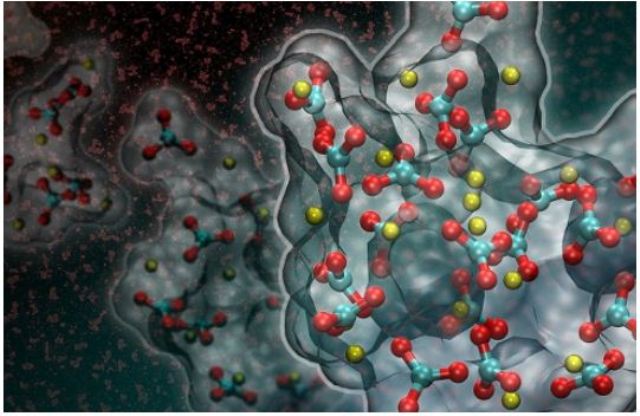An international team of researchers, including a geoscientist from Virginia Tech, has demonstrated how nature employs different pathways for crystal growth that outperform the classical, one-atom-at-a-time route.
 An international group of researchers has shown how nature uses a variety of pathways to grow crystals. This is an artistic rendering of molecular dynamics simulation results showing the formation of a liquid-like particle during the early stages of calcium carbonate crystallization. Credit: Adam F. Wallace/University of Delaware and David J. Carey.
An international group of researchers has shown how nature uses a variety of pathways to grow crystals. This is an artistic rendering of molecular dynamics simulation results showing the formation of a liquid-like particle during the early stages of calcium carbonate crystallization. Credit: Adam F. Wallace/University of Delaware and David J. Carey.
Crystals have long been studied in order to understand how they form into complex shapes. Crystals are an important in a range of materials, from soils and semiconductors to skeletons and shells. However, the formation of crystals still remains somewhat of a mystery.
The study results appeared in the journal Science, and provide new insights into the mechanism of growing minerals into shapes by plants and animals. These shapes are not at all related to their original crystal symmetry. The work also reveals the reasons for difficulty in removing certain contaminants from groundwater and stream sediments.
“Researchers across all disciplines have made observations of skeletons and laboratory-grown crystals that cannot be explained by traditional theories,” said Patricia Dove, a University Distinguished Professor and the C.P. Miles Professor of Science in the College of Science at Virginia Tech. “We show how these crystals can be built up into complex structures by attaching particles — as nanocrystals, clusters, or droplets — that become organized into complex shapes. Many scientists have contributed to identifying these particles and pathways to becoming a crystal — our challenge was to put together a framework to understand them.”
Based on several discussions among researchers from various fields, such as physics, biology, geochemistry, the earth and materials sciences, the results began to materialize. The researchers worked individually to perform various lab experiments, to study soils, streams, and animal skeletons, or to understand the mechanism behind the formation and attachment of particles using computer simulations.
A three-day workshop was held in Berkeley, California, for the researchers to discuss the results. It was sponsored by the Council on Geosciences of the Office of Basic Energy Sciences of the U.S. Department of Energy.
“Because crystallization is a ubiquitous phenomenon across a wide range of scientific disciplines, a shift in the picture of how this process occurs has far-reaching consequences,” said materials scientist and physicist James De Yoreo at the Department of Energy's Pacific Northwest National Laboratory. “Moreover, because we largely show a community consensus on this topic, the study has the potential to define the directions of future research on crystallization.”
In both animal and laboratory systems, particle formation is the initial step of the process. These particles can be clusters, droplets, nanocrystals or small molecules. They are unstable, and tend to join with each other and with crystals and other surfaces in close proximity. For instance, nanocrystals tend to attach in the same manner as Legos by orienting along the same direction as the larger crystal before attaching. Conversely, amorphous conglomerates tend to just aggregate.
The researchers explained that these atoms assemble themselves by “doing the wave” through the mass to rearrange into a single crystal at a later stage. They also highlighted the need for more research to understand the forces causing these particles to move and integrate.
“Particle pathways are tricky because they can form what appear to be crystals with the traditional faceted surfaces or they can have completely unexpected shapes and chemical compositions,” said Dove, the corresponding author of the study and a member of the National Academy of Sciences. “Our group synthesized the evidence to show these pathways to growing a crystal become possible because of interplays between of thermodynamic and kinetic factors.”
Gaining insights into the mechanism used by animals to form crystals into structures, including bones, teeth, and shells, will be helpful to understand crystal formation in nature. This knowledge will also help in designing innovative materials and illustrating abnormal mineral patterns in rocks. Similarly, understanding the way pollutants are trapped or transported in the minerals of sediments will be useful in the environmental management of soil and water.
"How we think about the ways to crystallization impacts how we interpret natural crystallization processes in geochemical and biological environments, as well as how we design and control synthetic crystal growth processes," said De Yoreo. "I was surprised at how widespread a phenomenon particle-mediated crystallization is and how easily one can create a unified picture that captures its many styles."
The Council on Geosciences of the U.S. Department of Energy, Office of Basic Energy Sciences, Chemical Sciences, Geosciences and Biosciences Division supported the research work.